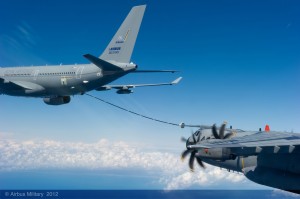2016-06-30 By Robbin Laird
During the Trade Media Brief 2016 meetings in Munich, Germany held on June 20 and 21, 2016, Miguel Ángel Morell, head of operations at Airbus Military. Formerly, he was head of Engineering and Technology at Airbus Military.
His brief highlighted innovations rooted in upgrades and the evolution of core platforms as well as shaping enhanced connectivity capabilities.
The connectivity piece is especially important to the future evolution of the Airbus military portfolio.
As was highlighted later by the head of Head of Military Aircraft at Airbus Defence and Space, Fernando Alonso, connectivity was key part of the future.

Alonso underscored the importance for the future in terms of shaping approaches with regard to “how to connect all of our platforms together.
We have a wide portfolio of platforms, and we believe that the future of this business is about connecting all of those platforms.”
Alonso turned immediately to what I see as the flagship program (and when the A400M has reached the point of a clear baseline aircraft going forward that will be the second one), namely the A330MRTT.
“The plane refuels from the wings.
That leaves all of the interior space to leverage.
There is so much volume that can be used intelligently to put in capabilities, to put in sensors, to put appropriate personnel, to connect to the battlefield.
That is where we will focus our attention.
We need to focus on developing their systems capability and their connection capability.”
Morell discussed one technology focused on the tanker, which the Aussies, have demonstrated a clear interest, because of their advanced experience in operating the tanker. The technology is a Joint Range Extension or JRE Link16 for tankers. The focus on integrating the enhanced linke within a wideband SATCOM architecture.
He highlighted that the LINK 16 JRE could be applied to operate as a Link 16 data relay within the C3I network or to access on board the tanker of information from Link 16 networks that can provide Beyond-Line-of sight information to the deployed forces as well.
He discussed an additional connectivity technology, not tied explicitly to the tanker, namely, airborne laser communication links.
Here the focus is upon connecitivye via laser communications between aircraft and spacecraft operating in a GEO orbit. An Airbus A310 test bed will transmit data (including video) making use of a Gb-capable channel through a Europe Data Relay Satellite (EDRS-A). This link will be able to operate at 1-2 magnitudes faster than a standard air-to-satellite link.
Another key technological development associated with the tanker was developing an automated refueling capability.
The launch customer for the tanker highlighted the importance of this technology during a visit to Australia.

Air Commodore Lennon highlighted an important development, which Airbus was working on for the tanker.
“They are working hard on building an autonomous boom where the boom will actually work out where the receptacle is and fly itself into contact.
This will ease the workload for the tanker crew, and provide significant capabilities to fuel new assets coming to the tanker, such as UAVs. It would be an important step forward.
If you have a good reliable autonomous system, then the boom operator is not tiring as quickly and so you can stay on station longer and enhance your persistence in the battle space.”
Miguel Ángel Morell provided an update on the approach introduced into the conversation in Canberra earlier this year.
The automated refueling system functions as an aide to the manual operator allowing him to process the demand side of the operation more rapidly and accurately.
It is designed to reduce risk while enhancing the speed and accuracy of a refueling operation.
And the new capability will allow for increasing the number of AAR operations performed during a mission.
The automated system has completed both its operational evaluation within the engineering simulator as well as initial operational evaluation in flight without contact. Later this year the flight test campaign will begin testing the system in doing actual refueling operations.
Other technologies highlighted in the briefing were the following:
An AAR refueling kit for a C295; a tactical ground collision avoidance system for the A400M;
Upgrades for the C-295 in terms of enhanced automation; and building a new hose system to refuel helicopters via an A400M in which the standard 80 foot hose was being tested to be replaced by a 120 foot hose;
Building a generic Ground Control Station for unmanned aerial systems;
The holding of a competition to engage the german academic community in developing new ideas for unmanned systems;
Further evolution of the weaponization of the Eurofighter;
And launching various technology demonstrators to shape a way ahead with the next generation of air combat systems.
In short, the technology program highlighted was part of the modernization strategy for the platforms and the enhanced capability to allow the platforms to more effectively connect with forces operating in the battlespace.

